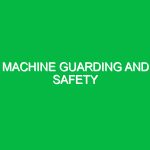Amputations in manufacturing settings can be devastating, impacting not only the lives of workers but also the productivity and morale of the entire organization. In an industry where machinery, tools, and processes are integral to daily operations, the risk of limb loss is alarmingly real. This article delves into the importance of preventing amputations in manufacturing environments, emphasizing its relevance in the Health, Safety, and Environment (HSE) domain. By exploring potential hazards, safety precautions, best practices, and regulations, we aim to equip employers and employees with the knowledge to foster a safer workplace.
Understanding the Importance of Preventing Amputations
Preventing amputations in manufacturing settings is not merely a compliance issue; it is a moral obligation. Each year, thousands of workers suffer severe injuries, including amputations, due to accidents involving machinery. According to the U.S. Bureau of Labor Statistics, approximately 2,000 amputations occur annually in the workplace, with manufacturing being one of the most affected sectors. These incidents can lead to long-term physical, emotional, and financial consequences for the affected individuals and their families. Furthermore, organizations face increased insurance costs, loss of skilled labor, and reputational damage. Thus, preventing amputations is critical for both ethical and business reasons.
Identifying Hazards and Risks in Manufacturing Settings
To effectively prevent amputations, it is essential to first identify the potential hazards present in manufacturing environments. These hazards can be categorized into several key areas:
1. Machinery and Equipment
One of the most significant risks comes from machinery and equipment. Power tools, conveyor belts, and heavy machinery can pose severe dangers if not properly safeguarded. For instance, a worker operating a lathe without adequate guards may inadvertently push their hand into the rotating part, leading to a catastrophic injury.
2. Manual Handling
Manual handling of heavy items can also lead to amputations, particularly if workers are not trained in proper lifting techniques. Inadequate training can result in workers using improper tools or taking unsafe shortcuts, increasing their risk of injury.
3. Lack of Safety Guards
Safety guards are essential components that prevent access to dangerous areas of machinery. When these guards are missing or improperly installed, the risk of an accident increases significantly. For example, a missing guard on a saw can lead to fingers or limbs being inadvertently placed in harm’s way.
4. Poor Housekeeping
Poor housekeeping can create hazards that may lead to accidents. Cluttered pathways, spilled materials, or misplaced tools can cause slips, trips, and falls, which may result in amputations if workers are caught in machinery during these incidents.
5. Inadequate Training and Awareness
Even the safest machines can be dangerous if workers are not adequately trained. Lack of awareness about risks associated with specific tasks can lead to dangerous behaviors that increase the likelihood of injury.
Safety Precautions and Best Practices
Once the hazards are identified, implementing effective safety precautions is crucial to preventing amputations in manufacturing settings. Here are some actionable strategies:
1. Regular Risk Assessments
Conducting regular risk assessments helps identify new or previously overlooked hazards. These assessments should be systematic and involve all employees, encouraging them to report any unsafe conditions they observe. The insights gathered can guide safety improvements.
2. Implementing Machine Safeguards
Installing appropriate machine safeguards is one of the most effective ways to prevent amputations. This includes using physical barriers, such as guards or shields, that prevent access to moving parts. Additionally, emergency stop mechanisms should be easily accessible and functional.
3. Comprehensive Training Programs
Training is paramount. Workers should receive comprehensive training on machinery operation, safe handling techniques, and emergency procedures. Regular refresher courses can help maintain safety awareness and ensure that new employees learn best practices from the outset.
4. Promoting a Safety Culture
Encouraging a culture of safety within the organization can significantly reduce risks. This involves fostering open communication about safety concerns and recognizing employees who prioritize safety. When workers feel empowered to speak up, they contribute to a safer environment.
5. Proper Use of Personal Protective Equipment (PPE)
While PPE cannot eliminate all risks, it plays a crucial role in injury prevention. Employers must ensure that employees have access to appropriate PPE, such as gloves, safety shoes, and protective eyewear, and that they are trained to use it correctly.
Regulations and Standards Governing Amputation Prevention
Various regulations and standards govern safety practices in manufacturing settings, and compliance is essential for preventing amputations. Some key regulations include:
1. Occupational Safety and Health Administration (OSHA) Standards
OSHA sets forth regulations that require employers to maintain a safe workplace. These regulations include specific standards for machine guarding (29 CFR 1910.212) and general safety and health provisions (29 CFR 1910). Employers must familiarize themselves with these standards to ensure compliance.
2. American National Standards Institute (ANSI) Guidelines
ANSI provides guidelines that emphasize the importance of safety in manufacturing. These guidelines include recommendations for machine safety and the proper use of PPE, guiding organizations in their efforts to prevent amputations.
3. National Institute for Occupational Safety and Health (NIOSH) Recommendations
NIOSH offers research-based recommendations for workplace safety. Their reports often focus on preventing specific injuries, including amputations, and provide valuable insights into best practices and risk mitigation strategies.
Real-Life Case Studies: Lessons Learned
Learning from past incidents can guide organizations in preventing future amputations. Here are a couple of hypothetical scenarios that illustrate the importance of safety measures:
Case Study 1: The Lathes Accident
In a small manufacturing facility, an employee was operating a lathe without a safety guard in place. During the operation, their clothing became caught in the machine, resulting in a severe injury that required amputation. Following the incident, the company instituted a mandatory safety protocol that included regular inspections of machinery and mandatory use of guards. As a result, they recorded no further incidents involving lathes.
Case Study 2: The Forklift Mishap
In another scenario, a worker was injured while attempting to retrieve a load from a crowded storage area. The clutter caused them to slip, leading to a fall that resulted in a limb being caught under a moving forklift. After reviewing this incident, the organization prioritized housekeeping and instituted a strict protocol to maintain clear walkways. This change significantly reduced accidents related to manual handling and equipment operation.
Conclusion
Preventing amputations in manufacturing settings is a multifaceted challenge that requires a proactive approach. By understanding the hazards, implementing robust safety measures, and adhering to regulations, organizations can create a safer environment for their employees. The commitment to safety not only protects workers but also enhances productivity and morale, fostering a culture where everyone thrives. Remember, every step taken toward safety is a step away from a potential tragedy. Prioritizing prevention today can save a life tomorrow.


